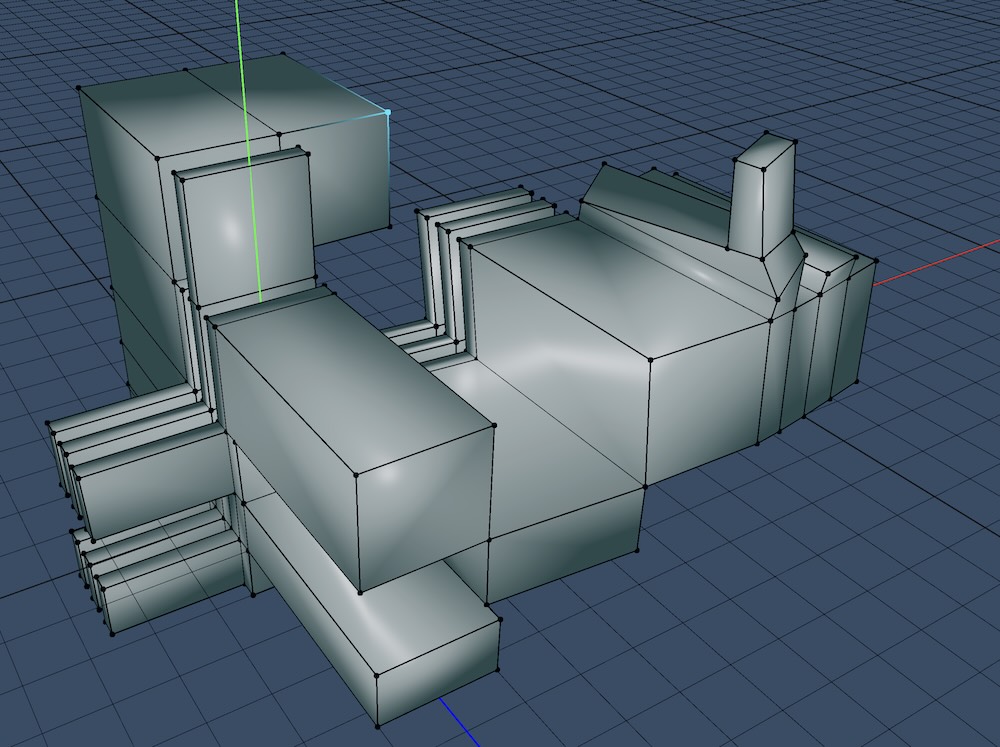One core data structure in the ShapeReality - 3D Modeling application is a non-manifold polygon mesh data structure. This data structure is a graph of Vertices, Edges and Faces. It takes inspiration from Blender's BMesh data structure, the Radial Edge Structure (see Nvidia SMLib - Topology documentation) and the paper Partial Entity Structure: A Compact Boundary Representation for Non-Manifold Geometric Modeling by Lee et al., but arrives at a simpler design that still has the desired feature set.
The data structure supports:
- non-manifold edges, meaning more than 2 faces can be connected to a given edge
- loose vertices (vertices with no edges connected to them)
- loose edges (edges with no faces connected to them)
The main goal of the data structure is to enable adjacency / topological queries:
- For a given vertex, which edges are connected to it?
- For a given edge, which faces are connected to it?
- For a given face, which vertices / edges make up the face?

Vertex uses
We wish to have fast insertion and deletion of elements, and no memory fragmentation. Therefore, a naive implementation such as:
struct Vertex {
std::vector<Edge*> connected_edges;
};
would not be a good idea.
Therefore, for a given Vertex, we add a circularly linked list of VertexUses:
// circularly linked list
struct VertexUse {
Vertex* vertex;
VertexUse* prev;
VertexUse* next;
Edge* connected_edge;
};
struct Vertex {
VertexUse* uses;
Point* point;
};
This way, we can iterate over all Edges of a given Vertex, and not have millions of separate instances of std::vector<Edge*>.
Edge uses
This same approach is then also used for Edges, which get an accompanying circularly linked list of EdgeUses to answer the question "for a given edge, which faces are connected to it?":
struct EdgeUse {
Edge* edge;
EdgeUse* prev;
EdgeUse* next;
Face* connected_face;
};
struct Edge {
EdgeUse* uses;
VertexUse* v0;
VertexUse* v1;
};
Face loop
Then, the final task is to add the FaceLoop, which answers the question "for a given face, which vertices / edges make up the given face?":
Note that we also store the vertex for a given FaceLoop segment, because v0 and v1 of an Edge are unordered.
// circularly linked list
struct FaceLoop {
Face* face;
FaceLoop* prev;
FaceLoop* next;
EdgeUse* edge;
VertexUse* vertex;
};
struct Face {
FaceLoop* loop;
};
Merging face loop and edge uses
Because a given EdgeUse is only attached to a single face, we can merge the FaceLoop linked list into the EdgeUse, thus reducing the need for an additional element type in the graph:
struct EdgeUse {
Edge* edge;
Face* attached_face;
// radial (circularly linked list)
EdgeUse* radial_prev;
EdgeUse* radial_next;
// face loop (circularly linked list)
EdgeUse* loop_prev;
EdgeUse* loop_next;
Vertex* loop_vertex;
};
This gives us the final structure:
struct EditableMesh{
Pool<Vertex> vertices;
Pool<Edge> edges;
Pool<Face> faces;
Pool<VertexUse> vertex_uses;
Pool<EdgeUse> edge_uses;
};
Conclusion
This post presents a simple, performant non-manifold polygon mesh data structure, that enables topological / adjacency queries.
If you want to try out the final result:



